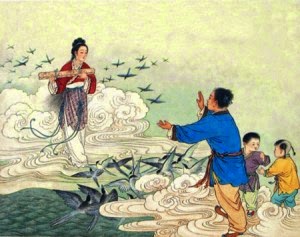The end of August is known as the period of "Limit of Heat," according to the 24 Chinese solar terms. During this time, we celebrate Qixi Festival, also known as Chinese Valentine's Day. Rooted in ancient Chinese folklore and traditions, this romantic holiday is widely celebrated in China.

The Story Behind Qixi Festival
At the heart of the Qixi Festival lies a romantic tale that dates back over 2,000 years, originating from Chinese mythology. The story revolves around two star-crossed lovers, Zhinü (the Weaver Girl) and Niulang (the Cowherd), who were separated by the Milky Way but reunited once a year on the seventh day of the seventh lunar month.
Zhinü, a talented weaver and celestial being, was banished to Earth for her mischievous behavior. While on Earth, she met Niulang, a kind-hearted cowherd, and the two fell deeply in love. Their love flourished, and they were eventually married and had two children. However, the Jade Emperor, ruler of the heavens, discovered their forbidden love and ordered Zhinü back to the heavens, creating the vast expanse of the Milky Way to keep them apart.
Touched by the couple's devotion, magpies formed a bridge across the Milky Way once a year, allowing Zhinü and Niulang to reunite on the seventh day of the seventh lunar month. This day became known as Qixi, a celebration of love and the bond between the two lovers.
Modern-Day Celebrations of Qixi Festival
Today, Qixi Festival has evolved into a cherished celebration of love, similar to Valentine's Day in Western culture. Celebrated on the seventh day of the seventh lunar month, which typically falls in August, Qixi Festival is a day for couples to express their affection for each other through various romantic gestures.
Gift Giving: Similar to Valentine's Day, exchanging gifts is a common tradition during Qixi Festival. Popular gifts include flowers, chocolates, and jewelry.

Chop Suey Club's curated Qixi collection includes sweet but psycho ceramics to add a little spice to your everyday life, the book "Experimental Relationship" by Pixy Liao that delves into the complexities of love and gender, and unique collectible film strips from Wong Kar Wai's romantic film "In the Mood for Love.".

Also in the Qixi 七夕 collection is Beijing Silvermine's Until Death Do Us Part collection. The collection features reclaimed photos discovered from a factory in an old factory in Beijing. The photos depict a dying tradition of smoking cigarettes at Chinese weddings, symbolizing the sharing of air and unity.
Romantic Activities: Couples often go out on romantic dates, so why not try a mahjong double date this year? Love is an intoxicating game of power dynamics, and so is the fun of playing mahjong. Rekindle your relationship while remembering to keep your inner turmoil at bay during this game. Enjoy 30% off our mahjong room to celebrate Qixi with your lovers using code 'MahjongLove' until Aug 12!
Prayer and Rituals: Traditional customs involve women praying to Zhinü for skills in weaving and needlework, hoping to enhance their craftsmanship. They also offer fruits, tea, and other items to honor Zhinü and seek her blessings.
Shop Chop Suey Club's Peach and Persimmon Jar and tea accessories: Petal Glass Tea Cup, Cabbage Glass Cup, & Hulu Liquor Sets.


For a more exquisite taste, check out our Boba Tea Splash Ring by Sublima and Kong Liao's Dunhuang Mural Teacup.
Qixi Festival and the 24 Solar Terms: Limit of Heat
In the traditional Chinese lunar calendar, Qixi Festival falls within the "Limit of Heat" (Shǔ), which is one of the 24 solar terms. We wrote on article on the significance of the 24 Chinese solar terms here. These terms divide the year into 24 segments, each corresponding to a specific astronomical event or natural phenomenon. The "Limit of Heat" marks the hottest period of the year, when temperatures peak and the earth is at its warmest.
The connection between Qixi Festival and the "Limit of Heat" is not coincidental. According to folklore, Niulang and Zhinü's reunion on Qixi occurred during a time when the heat of summer was at its zenith. This alignment of the romantic story with the hottest period of the year adds an extra layer of symbolism to the festival, portraying the intensity of their love amidst the scorching heat.
Heat, the color red, and fire are significant symbols in Chinese culture. Read our article "Five Elements - Fire 火" and check out our KIYOBI "Fire" Incense Sticks by Elemense.

For fire-spired jewelry for Qixi Festival, check out Chinese jewelry designer YVMIN's Fire Hoops and Sparkle Necklace set.
Qixi Festival, also known as Chinese Valentine's Day, is a celebration of love that intertwines ancient mythology, romanticism, and cultural traditions. The tale of Zhinü and Niulang resonates through generations, a testament to the enduring power of love. As modern celebrations continue to evolve, the essence of Qixi Festival remains true: a time for couples to express their affection, for lovers to unite, and for all to celebrate the boundless nature of love – even amidst the heat of summer.
Qixi Festival, also known as Chinese Valentine's Day, is a celebration of love that intertwines ancient mythology, romanticism, and cultural traditions. The tale of Zhinü and Niulang resonates through generations, a testament to the enduring power of love. As modern celebrations continue to evolve, the essence of Qixi Festival remains true: a time for couples to express their affection, for lovers to unite, and for all to celebrate the boundless nature of love – even amidst the heat of summer.


